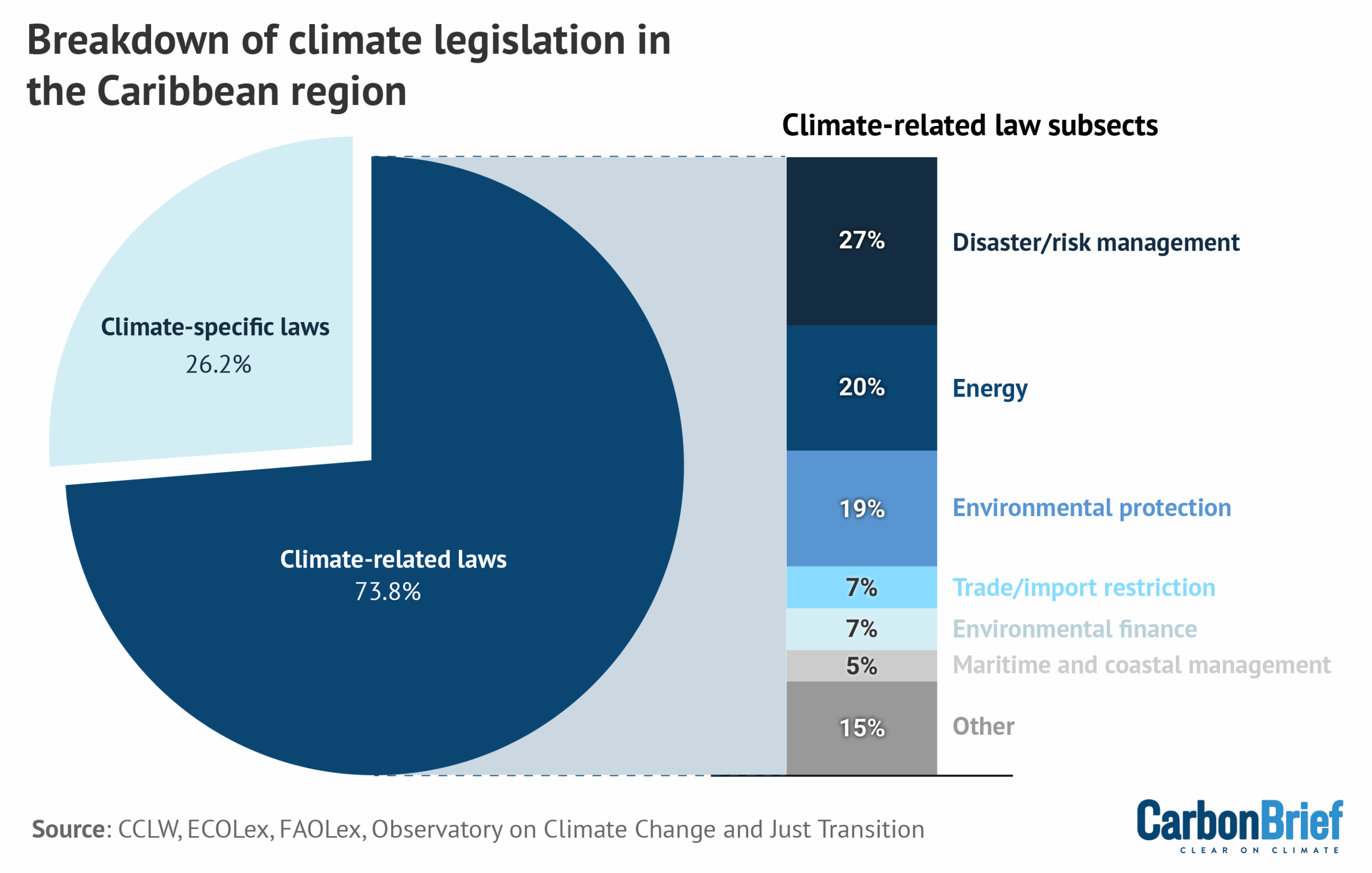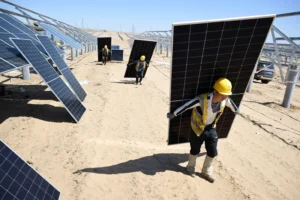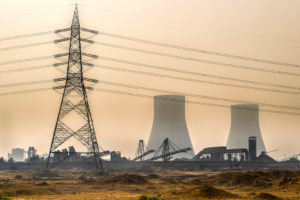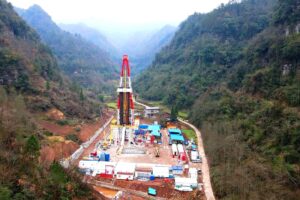The UK government’s “high-risk” research funding agency last week announced that it will invest £57m ($76m) in a new solar geoengineering research programme.
“Solar geoengineering” refers to methods that aim to address some of the impacts of a warming climate by reflecting away more sunlight from the Earth.
The programme, spearheaded by the Advanced Research and Invention Agency (Aria), will fund 21 projects globally.
This includes small-scale outdoor experiments, involving attempts to thicken Arctic sea ice and brighten clouds above Australia’s Great Barrier Reef to reflect away sunlight.
The news was reported breathlessly by the UK media, with some outlets conjuring images of the government one day “dimming the sun” or trying to modify the weather and others focusing on the “secretive” nature of Aria and its research.
The reaction was even more exaggerated on social media, where anonymous accounts seized upon the news to spread misinformation about existing “secret” government schemes to “control” the weather.
At the same time, the programme – first reported last year – has sparked legitimate debate among climate scientists, who have long held diverging views on whether more research funding should be channelled into solar geoengineering.
Below, Carbon Brief explains what the new solar geoengineering research programme consists of and explores the social and ethical concerns surrounding the technology.
- What is the UK’s new solar geoengineering research programme?
- How does this compare to past solar geoengineering efforts in the UK and globally?
- Why do some scientists say solar geoengineering research is needed?
- Why are there social and ethical concerns around solar geoengineering?
What is the UK’s new solar geoengineering research programme?
Solar geoengineering is a term used to describe a group of hypothetical technologies that could, in theory, counteract temperature rise by reflecting more sunlight away from the Earth’s surface. (It is also sometimes called “solar radiation modification”.)
The most commonly proposed idea is to introduce reflective aerosols high up into the stratosphere, which would lower global temperatures in a similar way to a volcanic eruption.
Other ideas include deliberately modifying clouds to make them more reflective or sending giant mirrors into space.

The proposals may sound futuristic, but the notion of engineering the climate in order to limit sunlight has been debated by scientists and politicians for more than 50 years.
However, these debates have always proved controversial, meaning – apart from studies based on computer simulations – little field research into solar geoengineering has been carried out. (See: How does this compare to past solar geoengineering efforts in the UK and globally?)
Aria’s new research programme aims to invest £57m in 21 solar geoengineering research projects globally.
This – along with a separate £10m scheme from the UK Research and Innovation body – means the UK is now one of the world’s biggest funders of solar geoengineering research.
Announcing the details of the scheme, Aria said its motivation for launching the research programme was “the possibility of encountering damaging climate tipping points”.
Out of the £57m, around £24.5m ($33m) will be spent on “controlled, small-scale outdoor experiments”, according to Aria.
These include attempts to thicken Arctic sea ice, brighten clouds above Australia’s Great Barrier Reef and to float weather balloons containing natural minerals high in the stratosphere, which will be retrieved after “hours or weeks”.
All outdoor experiments will be “scrutinised” by an oversight committee chaired by Prof Piers Forster, a leading climate scientist who is the founding director of the Priestley Centre for Climate Futures at the University of Leeds.
In a note released alongside news of the research funding, the oversight committee said it does “not exist to legitimise this programme”, adding:
“We advise Aria on the risks and benefits of supporting proposed creator projects and how best to work with and across creator teams to support learning and to help ensure that findings are contextualised and communicated appropriately alongside [climate] mitigation and adaptation options.”
Aria is a “high-risk, high-reward” government research agency that was formally established through an act of parliament in 2023.
It was originally conceptualised by Dominic Cummings, a controversial former adviser of then prime minister Boris Johnson.
According to Nature, Aria was modelled on the “famed US Defense Advanced Research Projects Agency, or DARPA, which helped to pioneer some of the world’s most consequential technologies, including the internet and personal computers”.
In its recent coverage, the Daily Telegraph described Aria as a “secretive government unit”.

Aria itself has said that it aims to be fully transparent about its solar geoengineering programme, which was its motivation for publicly announcing its spending on the 21 projects involved.
How does this compare to past solar geoengineering efforts in the UK and globally?
As mentioned above, the idea of solar geoengineering has been debated for more than 50 years. However, its controversial nature has meant that, until now, very few field experiments have been carried out.
In 2010, there was an attempt to carry out field research in the UK by the Stratospheric Particle Injection for Climate Engineering (SPICE) project, which was headed by Dr Matthew Watson at the University of Bristol and involved scientists from the University of Oxford, the University of Cambridge and the University of Edinburgh.
The project aimed to “investigate the effectiveness” of solar geoengineering, in part by releasing the equivalent of a bathtub of water high into the atmosphere above Norfolk.
However, it was met with fierce opposition by some campaign groups. In 2012, the team ended the project, citing issues with intellectual property and discomfort with the current lack of regulation and governance of solar geoengineering research.
(Watson is one of the recipients of Aria’s new research programme. His team has been awarded £4.3m ($5.7m) to build specialised drones to study emissions from regularly erupting volcanoes in Guatemala, Montserrat and Chile.)
Outside of the UK, another high-profile solar geoengineering experiment headed by researchers at Harvard University, called the Stratospheric Controlled Perturbation Experiment (Scopex), was also forced to disband following public disapproval.
In the private sector, a US start-up called Make Sunsets has begun releasing high-altitude balloons containing sulphur dioxide into the stratosphere, in an attempt to geoengineer the planet. It funds its activities by selling “cooling credits”.
The company has been banned in Mexico, where it previously launched balloons, and is currently being investigated by the US Environmental Protection Agency.
According to the online publication SRM360, funding for solar geoengineering has increased from $34.9m in 2010-14 to $112.1m in 2020-24. The vast majority of funding is concentrated in global-north countries and about half of all funding comes from philanthropic sources.
This week, scientists and policymakers are meeting in Cape Town, South Africa for the largest summit to date on the scientific, social and political implications of solar geoengineering.
Countries have agreed to a de facto moratorium on large-scale solar geoengineering under the Convention on Biological Diversity, a UN treaty that aims to protect biodiversity. (However, it is not legally binding.)
Why do some scientists say solar geoengineering research is needed?
Scientists agree that cutting global greenhouse emissions as soon as possible is key to tackling climate change.
But global emissions are still rising – and the prospect of limiting global warming to 1.5C above pre-industrial levels, the ambition of the landmark Paris Agreement, without first “overshooting” the target is fast vanishing.
This has led some scientists to call for more research into solar geoengineering ideas, including through small-scale experiments and trials.
Research based on computer modelling indicates that artificially cooling the planet by releasing reflective aerosols into the stratosphere using specialised planes could be effective at offsetting a range of climate impacts, such as more intense heatwaves and flooding, melting sea ice and higher tropical storm risk.
(One solar geoengineering scientist has estimated that halving global warming with reflective aerosols would involve a specialised fleet of about 100 planes releasing 1m tonnes of sulfuric acid each year by 2070.)
However, this type of solar geoengineering would not address rising CO2 levels, which are causing oceans to become more acidic and crops to become less nutritious, among other issues.
Some scientists have raised concerns that, if aerosols were used to address global warming, the world could be left at risk of a “termination shock”. That is, if aerosols were released and then suddenly stopped – as a result of political disagreement or a terrorist attack, for example – global temperatures could rapidly rebound.
This sharp temperature change could be “catastrophic” for wildlife, modelling studies have suggested. However, other research argues that the likelihood of a termination shock has been “overplayed” and that measures could be put in place to ensure that the risk is minimised.
There is also a risk that deploying aerosols from just one spot on Earth could cause uneven impacts for people. One research paper based on modelling found that releasing aerosols in just the northern hemisphere could lead to a decrease in rainfall – and, therefore, an enhanced drought risk – in India and the African Sahel.
Ultimately, advocates of solar geoengineering research tend to argue that the only way to understand more about the efficacy and risks of the technology is to study it further, whereas opponents say more research could be a “slippery slope” towards deployment.
Why are there social and ethical concerns around solar geoengineering?
As well as scientific uncertainties, experts have long warned that solar geoengineering poses large social, ethical and governance challenges.
Some scientists and campaigners are fundamentally opposed to the idea of manipulating the climate further in order to try to repair some of the damage caused by fossil-fuel emissions.
Writing in the Guardian, climate scientists Prof Raymond Pierrehumbert and Dr Michael Mann described Aria’s research programme as “like using aspirin for cancer”.
Indigenous groups have strongly opposed the idea of solar geoengineering and its research, often arguing it goes against their beliefs about living in harmony with nature.
Some scientists and campaign groups also believe that solar geoengineering could be viewed by politicians and the public as a quick “technofix” to climate change. If more research and development is channelled into these techniques, they argue, people may start to backpedal on their promises to cut their emissions.
This is often referred to as the “moral hazard” dilemma.
But other researchers have urged caution on this idea. One reason for this is that social experiments conducted with members of the public have found little evidence of the moral hazard problem existing in practice.
Advocates of solar geoengineering research say it should be viewed as a “supplement” to climate mitigation efforts rather than a “substitute” or “quick fix”.
However, many experts and commentators have pointed out that the technology presents a very large global governance challenge.
A fair and just deployment of solar geoengineering would require agreement between countries, experts have reasoned. At present, it is difficult to picture a global forum that could garner such collaboration, they say.
Prof Alan Robock, a professor in the department of environmental sciences at Rutgers University, summarised this issue neatly in a conversation with Carbon Brief in 2018, when he said:
“You’re asking if the world can come together and agree on geoengineering without agreeing on mitigation. I think the answer is for us to agree on mitigation. Paris is the first step, the pledges made there aren’t enough but have got to increase.”
Another concern is the “free-driver problem”, an idea that refers to the potential for a single country, group or even individual to unilaterally deploy solar geoengineering, even if it might cause negative impacts for others. This concern arises from the fact that solar geoengineering would be relatively cheap to carry out.
It has been argued that the free-driver problem poses a larger concern than ever in today’s increasingly polarised world, where lone politicians and billionaires hold large amounts of power.
These serious social and governance issues prompt some experts to say solar geoengineering should not be researched at all, but others to say it should be researched to try to address concerns.
Out of Aria’s £57m for solar geoengineering research, around £2.8m ($3.7m) is earmarked for governance and ethics projects.
In its latest assessment for how the world can address climate change, the world’s authority on climate science, the Intergovernmental Panel on Climate Change (IPCC), notes that there is “high agreement” among research papers that solar geoengineering “cannot be the main policy response to climate change and is, at best, a supplement to achieving sustained net-zero”.
The assessment also notes that solar geoengineering “may introduce novel risks for international collaboration and peace”.
The post Factcheck: How the UK is – and is not – studying solar geoengineering appeared first on Carbon Brief.
Factcheck: How the UK is – and is not – studying solar geoengineering
Greenhouse Gases
DeBriefed 10 October 2025: Renewables power past coal; Legacy of UK’s Climate Change Act; Fukushima’s solar future
Welcome to Carbon Brief’s DeBriefed.
An essential guide to the week’s key developments relating to climate change.
This week
Renewables overtake coal
‘HISTORIC FIRST’: Renewables have overtaken coal to become the world’s leading source of electricity for the first six months of this year in a “historic first”, BBC News said. The analysis, from the thinktank Ember, found the world generated “almost a third” more solar power in the first half of the year, compared with the same period in 2024, while wind power grew by “just over 7%,” reported the Guardian.
HEAVY LIFTING: According to the report, China and India were “largely responsible for the surge in renewables”, while the US and Europe “relied more heavily on fossil fuels,” the Guardian wrote. China built more renewables than every other country combined in the first half of this year, the newspaper added.
CONTINENTAL SHIFTS: A second report from the International Energy Agency (IEA) predicted a “surge” in global wind and solar capacity by 2030, but shaved 5% off its previous forecast, the Financial Times said. The IEA revealed that India is set to become the second-largest growth market for renewables after China, “with capacity expected to increase 2.5 times by 2030”, Down to Earth reported. The IEA also upped its forecast for renewables in the Middle East and north Africa by 23%, “helped by Saudi Arabia rolling out wind turbines and solar panels”, but halved the outlook for the US, the FT noted.
Around the world
- EV BOOM: Sales of electric and hybrid cars made up “more than half” of all new car registrations in the UK last month, a new record, according to data from the Society of Motor Manufacturers, reported BBC News.
- BANKING COLLAPSE: A global banking alliance launched by the UN to get banks to slash the carbon footprint of their loans and investments and help drive the transition to a net-zero economy by 2050 has collapsed after four years, Agence France-Press reported.
- CUTS, CUTS, CUTS: The Trump administration plans to cut nearly $24bn in funding for more than 600 climate projects across the US, according to documents reviewed by the Wall Street Journal.
- PEOPLE POWER: A farmer, a prison guard and a teacher were among those from the Dutch-Caribbean island Bonaire who appeared at the Hague on Tuesday to “accuse the Netherlands of not doing enough to protect them from the effects of climate change”, Politico reported.
400,000
The number of annual service days logged by the US National Guard responding to hurricanes, wildfires and other natural disasters over the past decade, according to a Pentagon report to Congress, Inside Climate News reported.
Latest climate research
- Politicians in the UK “overwhelmingly overestimate the time period humanity has left to bend the temperature curve”, according to a survey of 100 MPs | Nature Communications Earth and Environment
- Fire-driven degradation of the Amazon last year released nearly 800m tonnes of CO2 equivalent, surpassing emissions from deforestation and marking the “worst Amazon forest disturbance in over two decades” | Biogeosciences
- Some 43% of the 200 most damaging wildfires recorded over 1980-2023 occurred in the last decade | Science
(For more, see Carbon Brief’s in-depth daily summaries of the top climate news stories on Monday, Tuesday, Wednesday, Thursday and Friday.)
Captured

The UK’s Climate Change Act, landmark legislation that guides the nation’s response to climate change, is increasingly coming under attack from anti-net-zero right-leaning politicians. In a factcheck published this week, Carbon Brief explained how the UK’s Climate Change Act was among the first comprehensive national climate laws in the world and the first to include legally binding emissions targets. In total, 69 countries have now passed “framework” climate laws similar to the UK’s Climate Change Act, with laws in New Zealand, Canada and Nigeria among those explicitly based on the UK model. This is up from just four when the act was legislated in 2008. Of these, 14 are explicitly titled the “Climate Change Act”.
Spotlight
Fukushima’s solar future
This week, Carbon Brief examines how Fukushima helped to recover from nuclear disaster by building solar farms on contaminated farmland.
On 11 March 2011, an earthquake off the pacific coast of Japan caused 15m-tall waves to crash into the eastern region of Tōhoku, killing 19,500 people and injuring a further 6,000.
In the aftermath, flooding at the Fukushima Daichi nuclear power plant caused cooling systems to fail, leaching radioactive contaminants into the soil and leading to a major nuclear incident.
Some 1,200km2 around the site was restricted and up to 100,000 people were evacuated – in some cases forever.
In the years following, Japan entered a fraught debate about nuclear energy.
In 2010, nuclear power provided 25% of Japan’s electricity, but, in the years following the disaster, its 54 nuclear reactors were taken offline.
Successive governments have fought over reintroducing nuclear power. Today, some 14 reactors are back online, 27 have been permanently closed and another 19 remain suspended. (Japan’s newly-elected prime minister Sanae Takaichi has promised to make nuclear central to her energy strategy.)
Against this backdrop, Fukushima – a prefecture home to 1.8 million people – has emerged as a surprise leader in the renewables race.
In 2014, the Fukushima Renewable Energy Institute (FREA) opened with the twin goals of promoting research and development into renewable energy, while “making a contribution to industrial clusters and reconstruction”.
That same year, the prefecture declared a target of 100% renewable power by 2040.
Contaminated land
“A lot of these communities, I know, were looking for ways to revitalise their economy,” said Dr Jennifer Sklarew, assistant professor of energy and sustainability at George Mason University and author of “Building Resilient Energy Systems: Lessons from Japan”.
Once evacuation orders were lifted, however, residents in many parts of Fukushima were faced with a dilemma, explained Skarlew:
“Since that area was largely agricultural, and the agriculture was facing challenges due to stigma, and also due to the soil being removed [as part of the decontamination efforts], they had to find something else.”
One solution came in the form of rent, paid to farmers by companies, to use their land as solar farms.
Michiyo Miyamoto, energy finance specialist at the Institute for Energy Economics and Financial Analysis, told Carbon Brief:
“The [Fukushima] prefecture mapped suitable sites early and conducted systematic consultations with residents and agricultural groups before projects were proposed. This upfront process reduced land-use conflicts, shortened permitting timelines and gave developers clarity.”
As a result, large-scale solar capacity in Fukushima increased to more than 1,300 megawatts (MW) from 2012 to 2023, according to Miyamoto. Moreover, installed renewable capacity now exceeds local demand, meaning the region can run entirely on clean power when conditions are favourable, Miyamoto said.
Today, aerial pictures of Fukushima reveal how solar panels have proliferated on farmland that was contaminated in the nuclear disaster.

Charging on
Last year, 60% of Fukushima’s electricity was met by renewables, up from 22% in 2011. (The country as a whole still lags behind at 27%.)
And that is set to grow after Japan’s largest onshore windfarm started operations earlier this year in Abukuma, Fukushima, with a capacity of 147MW.
The growth of solar and wind means that Fukushima is already “ahead of schedule” for its 2040 target of 100% renewable power, said Miyamoto:
“The result is a credible pathway from recovery to leadership, with policy, infrastructure and targets working in concert.”
Watch, read, listen
OVERSHOOT: The Strategic Climate Risks Initiative, in partnership with Planet B Productions, has released a four-part podcast series exploring what will happen if global warming exceeds 1.5C.
DRONE WARFARE: On Substack, veteran climate campaigner and author Bill McKibben considered the resilience of solar power amid modern warfare.
CLIMATE AND EMPIRE: For Black history month, the Energy Revolution podcast looked at how “race and the legacies of empire continue to impact the energy transition”.
Coming up
- 12 October: presidential elections, Cameroon
- 13-14 October: Pre-COP, Brasilia, Brazil
- 13-18 October: World Bank Group/IMF annual meetings, Washington DC
- 14-17 October: 2nd extraordinary session of the Marine Environment Protection Committee at the International Maritime Organisation, London
- 15-16 October: Circle of Finance Ministers report
Pick of the jobs
- Buckinghamshire Council, principal climate change officer | Salary: £49,354-£51,759. Location: Aylesbury, Buckinghamshire
- Sustainable NI, sustainable business lead | Salary: £60,000. Location: Belfast, Northern Ireland
- Dialogue Earth, South Asia managing editor | Salary: £1,875 per month. Location: South Asia
DeBriefed is edited by Daisy Dunne. Please send any tips or feedback to debriefed@carbonbrief.org.
This is an online version of Carbon Brief’s weekly DeBriefed email newsletter. Subscribe for free here.
The post DeBriefed 10 October 2025: Renewables power past coal; Legacy of UK’s Climate Change Act; Fukushima’s solar future appeared first on Carbon Brief.
Greenhouse Gases
Guest post: How Caribbean states are shifting climate legislation
The Caribbean region is among the most vulnerable to climate change, despite historically contributing less than half of one percent of global greenhouse gas emissions.
Rising sea levels, extreme heat and more frequent and intense storms – such as the 2024 Hurricane Beryl, which made landfall in Grenada – pose urgent and growing threats to the small island states, coastal nations and overseas territories that comprise the Caribbean region.
With global progress to address climate change still too slow, Caribbean countries are taking matters into their own hands by enacting more robust legislation to help protect against climate risks.
In a new study published in the Carbon and Climate Law Review, we identified 78 climate laws and legally binding decrees across 16 Caribbean states, as well as two constitutional references to climate change and a growing recognition of the right to a healthy environment.
Our analysis suggests that, together, these developments are not only enhancing resilience, but also positioning Caribbean states as influential actors in the global climate arena.
Caribbean climate laws on the rise
Climate governance in the Caribbean has expanded significantly in recent years. In the past decade, countries such as Cuba and the Dominican Republic have embedded climate obligations and programmatic guidelines into their national constitutions.
At the same time, legislative recognition of the human right to a healthy environment is gaining momentum across the region. Six Caribbean nations now affirm the right in their constitutions, while 15 have recognised it through international instruments, such as the UN Council, UN Assembly and the Escazu Agreement, as shown in the figure below.

More recently, there has been a notable rise in targeted, sector-specific climate frameworks that go beyond broader environmental statutes.
Saint Lucia stands out as the only country with a climate framework law, or a comprehensive national law that outlines long-term climate strategies across multiple domains. Meanwhile, several other Caribbean governments have adopted climate-specific laws that focus on individual sectors, such as energy, migration and disaster management.
According to our analysis, more than a quarter of climate-relevant legislation in the region – comprising 21 laws and legally binding decrees – now has an explicit focus on climate change, as illustrated in the chart below.
Our research suggests that this represents an ongoing shift in legislative focus, reflecting changes in how climate legislation is being structured in one of the world’s most climate-vulnerable regions.

Caribbean nations are also advancing legal reforms to structure and institutionalise climate finance and market mechanisms directly into domestic law, aligned with Article 6.2 of the Paris Agreement.
For example, the Bahamas has introduced provisions for carbon credit trading, while Antigua and Barbuda, Barbados and Grenada have established national climate financing mechanisms to support mitigation and adaptation efforts.
Some states, including Belize and Saint Kitts and Nevis, have incorporated regional bodies such as the Caribbean Community Climate Change Centre – the climate arm of the intergovernmental Caribbean community organisation CARICOM – into national frameworks. This indicates an increasing alignment between regional cooperation and domestic law.
In addition to the influx of regulations specifically addressing climate change, Caribbean nations are also legislating broader environmental issues, which, in turn, could provide increased resilience from climate impacts and risks, as shown in the graph above.
Key trends in these types of climate-related laws include the expansion of disaster risk management governance, which addresses national preparedness for climate-induced weather events or related catastrophes. Likewise, energy law is an increasingly prominent focus, with countries including Antigua and Barbuda and Saint Vincent and the Grenadines integrating renewable energy and energy efficiency goals into national climate governance.
More broadly, many Caribbean nations have adopted wide-ranging and comprehensive environmental laws, many of which were developed in alignment with existing climate commitments. In combination, these legal developments reflect a dynamic and evolving climate governance landscape across the region.
Proactive vs reactive approaches
Despite general alignment with these broader regional trends, our research reveals distinct developmental pathways shaping domestic climate regulation.
In the eastern Caribbean, for example, we saw both proactive, long-term planning strategies and reactive, post-disaster reforms.
Saint Lucia’s multifaceted approach to climate resilience evolved steadily over the course of more than a decade. During this time, the country developed numerous adaptation plans, strengthened cross-sectoral coordination and engaged in institutional climate reforms in areas such as energy, tourism, finance and development.
More recently, the passage of Saint Lucia’s Climate Change Act in 2024 marked a milestone in climate governance, by giving legal force to the country’s obligations under the UNFCCC, the Kyoto Protocol and the Paris Agreement – making Saint Lucia one of the few small island states to incorporate global climate commitments into domestic law.
Our research indicates that this strategy has not only positioned the country as a more climate-resilient nation, but also solidified its access to international climate financing.
In contrast, Dominica’s efforts evolved more rapidly in the aftermath of Hurricane Maria in 2017, which destroyed over 200% of the country’s GDP. The storm’s impacts were felt across the country and hit particularly hard for the Kalinago people – the Caribbean’s last Indigenous community – highlighting the role of socioeconomic disparities in shaping climate vulnerability and resilience.
In response, the government passed the Climate Resilience Act, creating the temporary Climate Resilience Execution Agency for Dominica (CREAD).
Beyond establishing an exclusively climate-focused institution, the act aimed to embed resilience into governance by mandating the participation of vulnerable communities – including Indigenous peoples, women, older people and people with disabilities – in shaping and monitoring climate resilience projects.

As noted in a recent statement by the UN special rapporteur on Climate Change, Dr Elisa Morgera, these frameworks underscore the government’s ambition to become the world’s first “climate-resilient nation.”
Although challenges persist, Dominica’s efforts demonstrate how post-disaster urgency can drive institutional change, including the integration of rights and resilience into climate governance.
Uneven progress and structural gaps
Despite significant progress, our research shows that several key opportunities for climate governance across the Caribbean continue to exist, which could enable improvements in both resilience and long-term ambition.
The region’s legal landscape remains somewhat heterogeneous. While Saint Lucia has enacted a comprehensive climate framework law, the rest of the region lacks similar blanket legislation. This includes some states that entirely lack climate-specific laws, instead relying on related laws and frameworks to regulate and respond to climate-related risks.
Other nations have yet to adopt explicit disaster-risk management frameworks, leaving Caribbean populations vulnerable before, during and after climate emergencies. Most have yet to enshrine the right to a healthy environment at the national level.
Our research suggests that outdated legal frameworks are further limiting progress in addressing current climate risks. Because many of the longer-standing environmental laws in the region were adopted well before climate policy became a mainstream concern, some fail to address the nature, frequency and intensity of modern climate challenges, such as sea-level rise, tropical storms, wildfires, floods, droughts and other impacts.
More broadly, many Caribbean climate laws include limited integration of gender equity, Indigenous rights and social justice. As Caribbean nations such as Grenada and the Dominican Republic begin to link climate resilience with these issues, the region has an opportunity to lead by example.
Ultimately, capacity and resource constraints persist as significant barriers to implementation and adaptation.
The Caribbean region faces debt that exacerbates ongoing development challenges, a burden made heavier by the repeated economic shocks of climate-related disasters. Along with regional debt-for-resilience schemes, increased funding from high-emitting countries to support adaptation measures in climate-vulnerable nations – as endorsed under the Paris Agreement – is likely to be critical to ensuring the region’s climate laws can be executed effectively.
Global implications of Caribbean climate law
Our research suggests that Caribbean countries are outpacing other regions in terms of the scope and ambition of their climate laws. This legislation has the potential to serve as a model for climate-vulnerable nations worldwide.
Continuing efforts in the region show that legal frameworks in the field can not only drive resilience, embed rights and strengthen claims to international finance, but also highlight how regional cooperation and diplomacy can enhance global influence.
These findings demonstrate that innovation in climate law need not wait for action from major emitters, but can instead be led by those on the front lines of climate change.
The post Guest post: How Caribbean states are shifting climate legislation appeared first on Carbon Brief.
Guest post: How Caribbean states are shifting climate legislation
Greenhouse Gases
IEA: Renewables have cut fossil-fuel imports for more than 100 countries
More than 100 countries have cut their dependence on fossil-fuel imports and saved hundreds of billions of dollars by continuing to invest in renewables, according to the International Energy Agency (IEA).
It says nations such as the UK, Germany and Chile have reduced their need for imported coal and gas by around a third since 2010, mainly by building wind and solar power.
Denmark has cut its reliance on fossil-fuel imports by nearly half over the same period.
Renewable expansion allowed these nations to collectively avoid importing 700m tonnes of coal and 400bn cubic metres of gas in 2023, equivalent to around 10% of global consumption.
In doing so, the fuel-importing countries saved more than $1.3tn between 2010 and 2023 that would otherwise have been spent on fossil fuels from overseas.
Reduced reliance
The IEA’s Renewables 2025 report quantifies the benefits of renewable-energy deployment for electricity systems in fossil fuel-importing nations.
It compares recent trends in renewable expansion to an alternative “low renewable-energy source” scenario, in which this growth did not take place.
In this counterfactual, fuel-importing countries stopped building wind, solar and other non-hydropower renewable-energy projects after 2010.
In reality, the world added around 2,500 gigawatts (GW) of such projects between 2010 and 2023, according to the IEA, more than the combined electricity generating capacity of the EU and US in 2023, from all sources. Roughly 80% of this new renewable capacity was built in nations that rely on coal and gas imports to generate electricity.
The chart below shows how 31 of these countries have substantially cut their dependence on imported fossil fuels over the 13-year period, as a result of expanding their wind, solar and other renewable energy supplies. All of these countries are net importers of coal and gas.

In total, the IEA identified 107 countries that had reduced their dependence on fossil fuel imports for electricity generation, to some extent due to the deployment of renewables other than hydropower.
Of these, 38 had cut their reliance on electricity from imported coal and gas by more than 10 percentage points and eight had seen that share drop by more than 30 percentage points.
Security and resilience
The IEA stresses that renewables “inherently strengthen energy supply security”, because they generate electricity domestically, while also “improving…economic resilience” in fossil-fuel importer countries.
This is particularly true for countries with low or dwindling domestic energy resources.
The agency cites the energy crisis exacerbated by Russia’s invasion of Ukraine, which exposed EU importers to spiralling fossil-fuel prices.
Bulgaria, Romania and Finland – which have historically depended on Russian gas for electricity generation – have all brought their import reliance close to zero in recent years by building renewables.
In the UK, where there has been mounting opposition to renewables from right-wing political parties, the IEA says reliance on electricity generated with imported fossil fuels has dropped from 45% to under 25% in a decade, thanks primarily to the growth of wind and solar power.
Without these technologies, the UK would now be needing to import fossil fuels to supply nearly 60% of its electricity, the IEA says.
Other major economies, notably China and the EU, would also have had to rely on a growing share of coal and gas from overseas, if they had not expanded renewables.
As well as increasing the need for fossil-fuel imports from other countries, switching renewables for fossil fuels would require significantly higher energy usage “due to [fossil fuels’] lower conversion efficiencies”, the IEA notes. Each gigawatt-hour (GWh) of renewable power produced has avoided the need for 2-3GWh of fossil fuels, it explains.
Finally, the IEA points out that spending on renewables rather than imported fossil fuels keeps more investment in domestic economies and supports local jobs.
The post IEA: Renewables have cut fossil-fuel imports for more than 100 countries appeared first on Carbon Brief.
IEA: Renewables have cut fossil-fuel imports for more than 100 countries
-
Climate Change2 years ago
Spanish-language misinformation on renewable energy spreads online, report shows
-
Climate Change2 months ago
Guest post: Why China is still building new coal – and when it might stop
-
Climate Change Videos2 years ago
The toxic gas flares fuelling Nigeria’s climate change – BBC News
-

 Greenhouse Gases1 year ago
Greenhouse Gases1 year ago嘉宾来稿:满足中国增长的用电需求 光伏加储能“比新建煤电更实惠”
-
Greenhouse Gases2 months ago
Guest post: Why China is still building new coal – and when it might stop
-

 Climate Change1 year ago
Climate Change1 year ago嘉宾来稿:满足中国增长的用电需求 光伏加储能“比新建煤电更实惠”
-

 Carbon Footprint2 years ago
Carbon Footprint2 years agoUS SEC’s Climate Disclosure Rules Spur Renewed Interest in Carbon Credits
-
Renewable Energy3 months ago
US Grid Strain, Possible Allete Sale


















